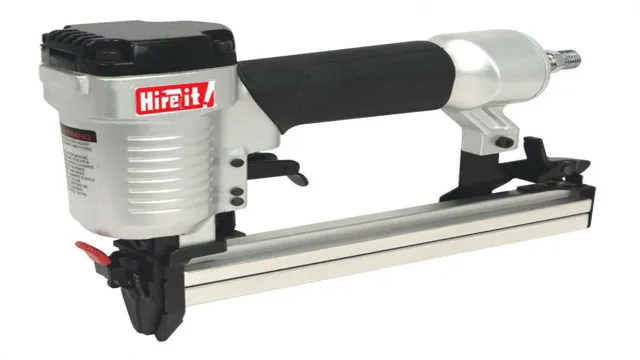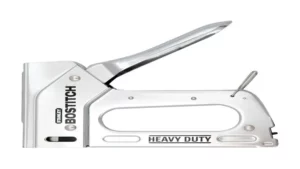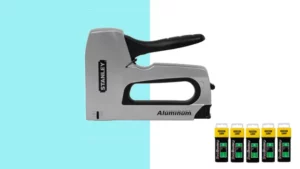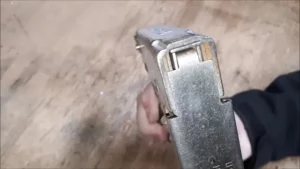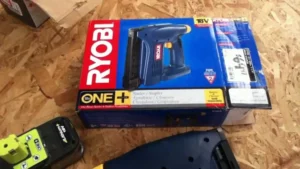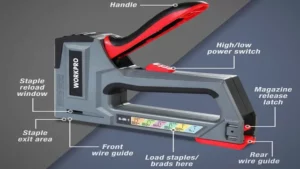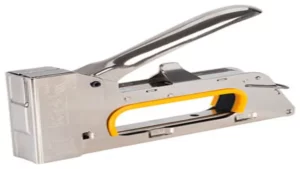Have you ever found yourself in a situation where you needed to join two pieces of material together quickly and securely? Perhaps you needed to staple a piece of fabric or upholstery in place, or fasten a fence panel together. Whatever the task, a staple gun might just be the tool you need! A staple gun is a handheld device that is used to drive metal staples into materials such as wood, fabric, or plastic. Unlike a traditional stapler, which is used to fasten paper and other lightweight materials, a staple gun is designed for more heavy-duty applications.
Staple guns come in a variety of shapes and sizes, from manual models that require the user to squeeze a trigger to fire the staple, to electric or pneumatic versions, which allow for faster and more efficient stapling. Whatever type of staple gun you choose, it’s important to select the appropriate staple size and type for the job at hand. So next time you’re faced with a DIY task that requires a secure and long-lasting fix, consider investing in a staple gun.
With the right tool in hand, you’ll have the confidence to tackle any project with ease.
Understanding PSI in Staple Guns
When it comes to staple guns, understanding PSI is crucial to ensuring proper usage and effectiveness. But how much PSI is needed for a staple gun? The answer depends on the specific staple gun model and the type of material being stapled. Generally, a staple gun requires at least 60 PSI to function properly, while heavier-duty staple guns may require up to 100 PSI.
However, it’s essential to note that excessively high PSI can damage the material being stapled or even break the staples themselves. It’s best to consult the manufacturer’s instructions to determine the appropriate PSI for your specific staple gun and project. Remember to always wear appropriate safety gear when using a staple gun and to take necessary precautions to avoid injury.
Definition of PSI
When it comes to using staple guns, understanding PSI is crucial. PSI stands for pounds per square inch and it measures the amount of pressure the staple gun can produce. The higher the PSI, the more forceful the staple gun will be.
This is important to consider because different stapling jobs require different levels of force. For example, a heavy-duty task will require a higher PSI than a simple home project. It’s important to check the PSI before purchasing a staple gun to ensure it’s suitable for the job at hand.
Think of PSI like the weight you lift at the gym, you wouldn’t use the same weight for every exercise, and the same goes for using a staple gun. Make sure to use the appropriate PSI for each specific job to avoid any mishaps or damage.
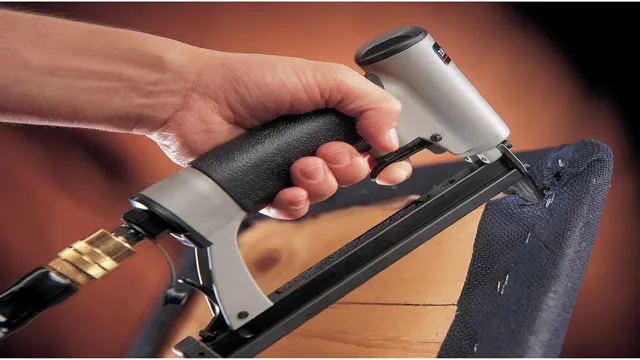
How PSI Impacts Staple Guns
When it comes to staple guns, PSI (pounds per square inch) is a crucial factor that impacts their performance. Understanding PSI in staple guns is important because it determines the power and force with which staples are fired into the material you’re working on. If the PSI is too low, the staples won’t penetrate the material properly and may become loose over time.
On the other hand, if the PSI is too high, it can damage the material and even cause the staple gun to jam. It’s important to match the PSI of the staple gun with the material you’re working on to ensure optimal performance. So, the next time you’re using a staple gun, make sure to pay attention to the PSI and adjust it accordingly.
Factors to Consider Before Determining PSI for a Staple Gun
When it comes to staple guns, determining the right amount of PSI (pounds per square inch) is crucial for achieving the desired results. Before settling on a specific PSI level, it is important to consider a few factors. One of the most important factors to keep in mind is the type of material you will be working with.
Different materials require different PSI levels to effectively penetrate the surface without causing damage. Another factor to consider is the size of the staples you will be using. Thicker staples may require higher PSI levels to effectively penetrate the material.
Additionally, it is important to ensure that your staple gun is compatible with the PSI level you plan to use. Using too much pressure on a gun that is not designed to handle it can result in damage to both the tool and the material being worked on. Ultimately, taking the time to consider these factors and choosing the appropriate PSI level for your specific project can ensure successful, quality results every time.
Size and Type of Staples Used
When it comes to determining the PSI for a staple gun, there are several important factors to consider, including the size and type of staples used. Different types and sizes of staples require different levels of force to penetrate various materials. For example, thicker and longer staples may require a higher PSI setting, while smaller and thinner staples may not.
Additionally, the type of staple can also affect the PSI needed. For instance, if you’re using a staple gun with a narrow crown, you may need less PSI compared to a gun with a wider crown. It’s important to refer to the manufacturer’s recommendations for your specific staple gun and to test various PSI settings on scrap materials before starting your project.
By taking the time to properly assess these factors, you can ensure that your staple gun delivers the appropriate amount of force for the task at hand, allowing you to complete your project efficiently and with precision.
Thickness of Material Being Stapled
When it comes to determining the PSI for a staple gun, the thickness of the material being stapled is a crucial factor to consider. Different materials require different levels of pressure to be stapled efficiently and effectively. For example, stapling through thin paper requires a much lower PSI than stapling through thicker materials like wood or metal.
It’s essential to use the appropriate amount of pressure to avoid damaging the material or causing the staple to bend or break. Finding the right PSI for the material you’re working with can be done through trial and error, or by consulting the staple gun’s user manual. Remember, always start with a lower PSI and gradually increase it until you achieve the desired results.
Keeping the thickness of the material in mind when determining PSI will ensure that you’re using your staple gun safely and correctly.
Type of Staple Gun
When selecting a staple gun, one of the key factors to consider is the type of staple gun you need. This can impact the required PSI for proper performance. For example, a manual staple gun may require less PSI than an electric or pneumatic staple gun.
Other factors that can impact PSI requirements include the size and type of staple being used, the material being stapled, and the thickness of the material. It’s important to carefully consider these factors to ensure the staple gun you choose is powerful enough to handle the job at hand. If you opt for a staple gun that doesn’t provide enough PSI, it may not be able to staple materials effectively, causing frustration and potentially damaging your materials.
Ultimately, understanding the type of staple gun you need and the PSI requirements for that type of gun will help you make an informed decision and get the best results from your stapling projects.
Recommended PSI for Staple Guns
When it comes to staple guns, knowing the recommended PSI is essential for getting the job done right. The ideal PSI range for a staple gun typically falls between 60 and 100. However, there are some factors to consider, such as the thickness of the material you’re stapling and the size of the staples you’re using.
For instance, if you’re working with thicker materials, you may need to increase the PSI to ensure the staples penetrate properly. Always check the user manual for your staple gun to see what the recommended PSI is for your specific model. Additionally, it’s important to remember that different air compressors may deliver different levels of PSI, so be sure to check the pressure gauge regularly to ensure you’re maintaining the proper PSI range.
By using the recommended PSI, you’ll be able to achieve clean and accurate stapling results every time.
Manual Staple Guns
When it comes to using manual staple guns, it’s important to know the recommended PSI for optimal performance. The PSI, or pounds per square inch, refers to the pressure at which the compressed air exits the air compressor and enters your air tools. Different staple guns require different PSI to function properly.
For manual staple guns, the recommended PSI varies from 60 to 100 depending on the size of the staple and the thickness of the material you are working with. It’s always best to refer to the manufacturer’s instructions to ensure you are using the correct pressure for your staple gun. Using the wrong PSI can result in incomplete stapling or damage to the tool itself.
With the right PSI, your manual staple gun can help you efficiently complete your DIY projects or professional tasks with ease.
Electric Staple Guns
Electric Staple Guns When it comes to electric staple guns, the recommended PSI (pounds per square inch) can vary based on the specific model and application. However, in general, most staple guns require a PSI between 60-100. It is important to note that if the PSI is too low, the staple may not fully penetrate the material, while if it is too high, it can damage and potentially break the staple gun.
It is always best to consult the user manual for your specific staple gun model to determine the recommended PSI range. It is also important to ensure that you are using the correct size and type of staple for your application to ensure the best results. By following these guidelines, you can ensure that your electric staple gun performs at its best and delivers reliable and consistent results every time.
Conclusion – Finding the Right PSI for Your Staple Gun
As with any tool, the amount of psi needed for a staple gun depends on the task at hand. Are you trying to secure delicate fabrics or heavy-duty wood boards? The answer may vary. Ultimately, finding the right pressure setting for your staple gun is like finding the right shade of lipstick – it’s all about the perfect balance between form and function.
“
FAQs
1. What is the recommended PSI for a staple gun? A: The recommended PSI for a staple gun usually falls between 70-120 PSI, however, it may vary depending on the type and brand of the staple gun. 2. Can I use a high PSI with my staple gun? A: It is not recommended to use a higher PSI as it may cause damage to the staple gun, material, or even the user. Always follow the recommended PSI for your specific staple gun. 3. What can happen if I use a lower PSI than recommended for my staple gun? A: If a lower PSI is used, the staple may not be properly driven into the material, causing it to be loose and potentially fall out. It may also cause the staple gun to malfunction. 4. How do I adjust the PSI on my staple gun? A: The PSI can typically be adjusted on the air compressor that the staple gun is connected to. Refer to the owner’s manual for specific instructions on how to adjust the PSI for your staple gun. 5. Is it necessary to use a regulator with my staple gun? A: Yes, a regulator is necessary to maintain a consistent and safe PSI for your staple gun. It helps to control the flow of air and prevent damage to the tool or material. 6. Can I use a staple gun without an air compressor? A: Yes, there are electric and battery-powered staple guns available that do not require an air compressor. However, their PSI and staple capacity may be limited compared to pneumatic staple guns. 7. What type of staple gun is best for heavy-duty projects? A: A pneumatic staple gun with a higher PSI range and larger staple capacity is typically best for heavy-duty projects. Be sure to choose a staple gun with the appropriate specifications for your specific project.
